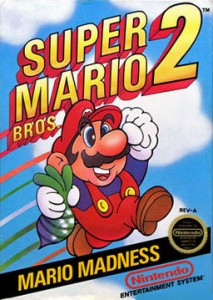319th played so far
 Genre: Platform
Genre: Platform
Platform: NES
Year of Release: 1988
Developer: Nintendo
Publisher: Nintendo
Speaking of old favourites – after Doom last time we now get another old favourite (although I’d dare say more mine than Peter’s this time). It’s the memories of our old NES, as well as the memories of playing it with friends before then. While we first all played the original Super Mario Bros., its sequel was such a big jump that it barely seemed like the same game.
There’s a reason for that – the US Super Mario Bros. 2 was actually a Japanese tie-in game called Doki Doki Panic. With the Japanese Super Mario Bros. 2 (or Lost Levels to us) being deemed too difficult (and to be honest, fairly similar to the first), we got this colourful world with some Mario theming added.
But despite all the missing elements – which didn’t feel missing at the time, as we didn’t know what the standard was for Mario games and what would change – the improvements were brilliant, the design inspiring, and the game as a whole so much fun…
But we’re getting ahead of ourselves here.
Our Thoughts
Yeah, sorry, the above said quite a bit. But that’s because it still applies. The game is a bit dated in graphics, perhaps, but beyond that so many things work nicely. Character switching, with each of the four having quite distinctive characteristics, differing in jump height, tightness of control and digging speed (and the Princess’s levitation as her own special power).
The true contribution the game makes, then, isn’t necessarily any one of its particular features – in fact, a number of the more interesting ones, such as standing on enemies and lifting were half-forgotten or only partially adopted afterwards – but the imagination put into the world and the experiments with the formula it introduced. Again, it’s not its own, but it’s hard to imagine the colourful, varied worlds of Super Mario Bros. 3, Super Mario 64 or others to exist without this game doing it first.
Not just that, but as much as the aforementioned improvements weren’t always fully adopted, they introduced an idea of experimenting with gameplay fare more than the leap between the first two Super Mario Bros. games had. It doesn’t feel afraid to try and see what works, what sticks, and what is a good diversion for this game.
Probably one of the largest things that lasted through the generations, however, is the cast the game introduced. While some of the bad guys – bosses in particular, including the big bad Wart – never show up again, a lot of the smaller fries stay around. The Bob-Ombs return almost immediately, in this game’s sequel, but others come through later, with Shyguys in particular reaching recurring character level, and (gender-flexible) Birdo (originally mislabelled in the game as Ostro too…) being a friend more than an enemy in more recent games.
Even so, that’s all in the future – as said, when we originally played the game, we didn’t know this. Instead, we thought this was normal for a Mario game. It was magical, a different journey from what we were used to. One that feels as special and (more important) well executed even today.
Final Thoughts
Alright, I’ll admit it – there’s no real way I could be objective about this, as it’s too tied up in my memories of it two decades ago. Even so, even playing it now – used to so much more from games – it’s as brilliantly put together as ever. Its strengths has endured and I’m still happy this is what we got to play here.